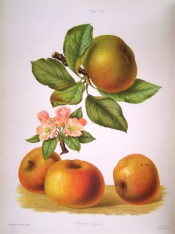Malus domestica ‘Blenheim Orange’
‘Fruit large, roundish, of a yellowish colour, tinged with red next the sun; pulp sweet and high flavoured: ripe in November, and keeps till March: a very superior dessert apple.’ [FCM p.42/1843].
Horticultural & Botanical History
‘This valuable apple was first discovered at Woodstock, in Oxfordshire, and received its name from Blenheim, the seat of the Duke of Marlborough. The exact date of its origin is not known.’ It is certainly pre 1818. [HP pl.VII/1878].
Fruit; large, globular, somewhat flattened, regularly shaped. Skin; yellow, tinged dull red next the sun, streaked deeper red. Flesh; yellow, crisp, juicy, sweet and pleasantly acid. Produces a large tree and is an abundant cropper. ‘A valuable and highly esteemed apple, either for dessert or culinary purposes, but strictly speaking, more suitable for the kitchen than the parlour.’ Ripens November to February. A good keeping apple, and I believe the flavour is enhanced as it ages and begins to wrinkle. The author of the 'Herefordshire Pomona' noted: ‘The plate represents not only the fruit when fit to gather from the tree, with the leaves and blossom, but also shows the rich ripe tints when it takes its place of honour on the Christmas dinner table.’ [HP pl.VII/1878. Gard. Chron. 1851, 1853].
An correspondent to 'The Gardeners Chronicle' of 1849 described the fate of the original tree. ‘In a somewhat dilapidated corner of the decaying borough of ancient Woodstock, within 10 yards of the wall of Blenheim Park, stands all that remains of the original stump of that beautiful and justly celebrated apple, the Blenheim Orange. It is now entirely dead and falling into decay, being a mere shell about ten feet high, loose in the ground, and having a large hole in the centre; till within the last three years, it occasionally sent up long, thin, wiry twigs, but this last sign of vitality has ceased, and what remains will soon be the portion of the woodlouse and the worm. Old Grimmett, the basket-maker, against the corner of whose garden-wall the venerable relict is supported, has sat looking on it from his workshop window, and while he wove the pliant osier, has meditated, for more than fifty successive summers, on the mutability of all sublunary substances, on juice, and core, and vegetable, as well as animal, and flesh, and blood. He can remember the time when, fifty years ago, he was a boy, and the tree a fine, full-bearing stem, full of bud, and blossom, and fruit, and thousands thronged from all parts to gaze on its ruddy, ripening, orange burden; then gardeners came in the spring-tide to select the much coveted scions, and to hear the tale of his horticultural child and sapling, from the lips of the son of the white-haired Kempster. But nearly a century has elapsed since Kempster fell, like a ripened fruit, and was gathered to his fathers. He lived in a narrow cottage garden in Old Woodstock, a plain, practical, laboring man; and in the midst of his bees and flowers around him, and in his “glorious pride,” in the midst of his little garden, he realized Virgil's dream of the old Corycian: — “Et regum equabat opes animis.” The provincial name for this apple is still “Kempster's Pippin,” a lasting monumental tribute, and inscription, to him who first planted the kernel from whence it sprang.”’
By 1852 ‘the last remnant of the stem of the original tree which first produced this celebrated apple is no more – the sapless and moulding relic exists no longer; that which the wood-louse and the worm were gradually consuming, the elements and the hand of man have hastened to a swifter decay. The rain and wind of the autumn of 1852 levelled the rotten and hollow shell, and the broken fragments have been gathered up and committed to the fire.’ [Gard. Chron. 1849, 1852].
‘This is a fine large variety, suitable for table or cooking.’ [David Crichton. NHM. vol.1 p60/1864].
History at Camden Park
Listed in the 1850 and 1857 catalogues [Apple no.43/1843].
Notes
My favourite apple. I haven’t tasted one in forty years but can still remember the taste of a stored Blenheim. Recently re-introduced to the Camden Park gardens.
Published Apr 16, 2010 - 01:57 PM | Last updated Jul 25, 2011 - 03:28 PM

Apple ‘Blenheim Orange’ | HP pl.7/1878 | RBGS. This apple was one of few allocated a plate to itself, testament to its worth.
| Family | Rosaceae |
|---|---|
| Category | |
| Region of origin | Garden origin, England |
| Synonyms |
|
| Common Name | Apple, Dessert apple, Culinary apple, Keeping apple |
| Name in the Camden Park Record |
Blenheim Orange
|
| Confidence level | high |